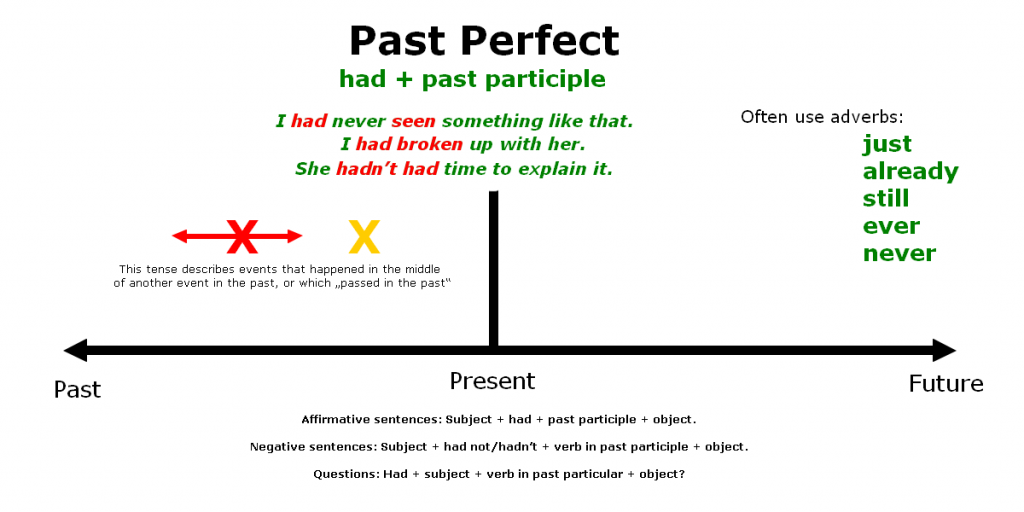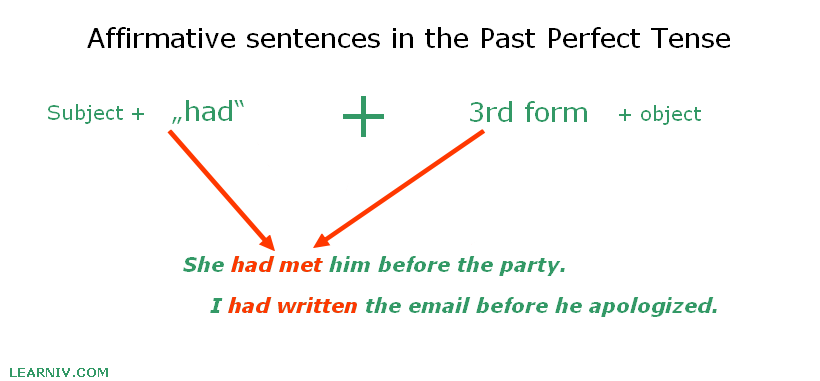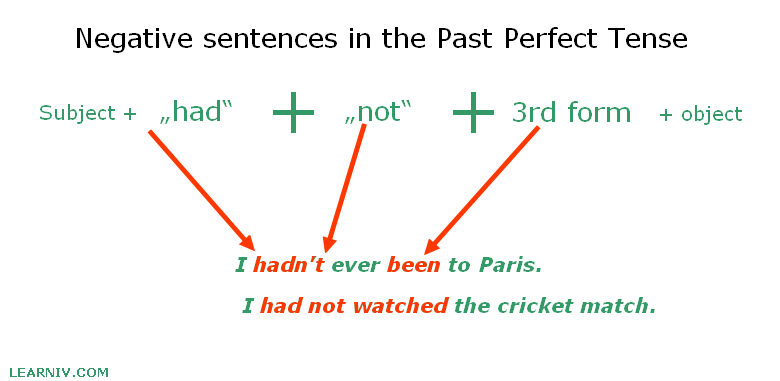The past perfect tense is used to show that something happened before another action in the past. It is also called pluperfect.
The past perfect, sometimes called pluperfect, describes events in the past. This is a specific type of tense and even when it seems hard to use, it is actually pretty easy. This tense describes events that happened in the middle of another event in the past, or which „passed in the past“. To construct the past perfect tense, we need to know all the irregular verbs and their forms.
Look at past perfect tense examples.
The formula for the past perfect tense
To form the past perfect tense we need to use verb „have“ in its irregular form, meaning we will always use „had“. The verb „had“ is combined with a verb in the past participle form (in the 3rd form).
The past perfect tense is easier in the sense that we do not have to distinguish plural or singular subjects or persons. We just always use the verb „had“ before the main verb, no matter what.
The complete sentence would be as follows:
Subject + had + past participle + object.
Differences between the past perfect tense and past simple tense
When you are talking about some event that happened before some other event in the past, you will use the past perfect tense. That‘s because the past perfect allows you to describe a specific time in the past, whereas the past simple doesn’t.
With the past perfect you can convey the sequences of events – everything will be clearer and more specific.
Example:
- I found out that he used washable paint. – Past simple
- I found out that he had used washable paint. – Past perfect
The difference between these two sentences is not that big, but both of them describe something else.
The first sentence is talking about using washable paint. The past simple used in this sentence describes that he could use this washable paint many times, meaning it could be a habit. Because he used it many times, we use the past simple.
If we use the past perfect tense, we talk about one single event that happened in the past. I found out that he had used the washable paint only once, only in this particular instance. Since it is clear that we are talking about a specific instance of using the paint, we use the past perfect tense.
See also 10 more examples of Past Perfect Tense sentences in another article.
When do we use the past perfect tense?
We use the past simple on many occasions. This tense is used to specify events in the past. In contrast to the past simple, in the past perfect tense we know when the action happened and can find more specific information about the sequences of events.
Completed action before something else in the past
The past perfect tense is often used to describe something that occurred before another event in the past. We can also use it for actions that happened before a specific point in time in the past.
Example:
- I did not have a lot of money because I had lost my job.
- I had never seen anything like that before I came to New York.
- She knew what was going to happen in that movie because she had read the book.
All of these sentences are describing actions that happened before another action in the past. We use very often adverbs like „because“ or „before“.
Duration of the event in the past
We use the past perfect tense to describe that some event had lasted in the past before some other event/action happened. We use it when something started in the past, had duration and continued until another action occurred.
Example:
- Before I broke my car, I had had it for 10 years.
- They were sad about giving their dog away because he had lived with them for 4 years and was a part of their family.
Notice that in the first sentence we use the verb „had“ twice. If we want to describe that we had something (owned it), we need to use the verb „had“ to describe its past perfect and another verb „had“ as the main verb in its past participle form.
When do we NOT use the past perfect tense?
We do not use the past perfect tense when we are not trying to convey a sequence of events. If you are just telling someone some information from the past with no sequences, do not use the past perfect. Use it only if the events you are talking about are following some other events.
But if you are asked to answer a question like the following, you will use the past perfect tense:
- „What did you do after you found out she was cheating on you?“
- You will answer with „I had broken up with her.“
Because your answer follows an event in the past, you will use the past perfect tense. In the above case we used the past perfect because it „passed in the past“. If there is no context, do not use the past perfect. Use the past perfect only if it is clear what you are talking about and others know the sequence of events.
We have prepared a complete list of irregular verbs in English. It contains more than 600 verbs, sorted by difficulty.
Affirmative sentences
Affirmative past perfect tense is made from the 3rd form of the verb „have“ and a verb‘s 3rd form (past participle). In contrast to the past simple, we do not care about the number of subjects or whether they are singular or plural. All subjects are used in combination with „had + past participle“.
This tense is a little harder because we need to know all of the verbs used as well as their irregular forms. If we do not memorize them and do not know them, we are unable to construct a full sentence.
The complete sentence would be as follows:
Subject + had + past participle + object.
Example:
- I had never been to London until today.
- After she had done her homework, she played football.
- I didn’t say a word until she had finished her story.
Negative sentences
To describe the negative meaning of a sentence in the past perfect tense, it is necessary to use the auxiliary verb „had not“ or its shorter form „hadn‘t“. We put it in front of the main verb in the past participle.
The complete sentence would be as follows:
Subject + had not/hadn’t + verb in past participle + object.
Examples:
- I had not ever eaten in this restaurant until this day.
- I hadn’t ever been to Paris before moving there.
- She hadn’t had time to explain it before seeing him.
Just like with affirmative sentences, we do not distinguish between the person or singular/plural subject.
Questions
To form a question in the past perfect tense, we have to put the verb „had“ at the beginning of the sentence. We even put it in front of the subject.
The rest of the sentence is similar to affirmative sentences. In questions we still use the verb in its past particular form, so the only difference between affirmative sentences and questions is in the positioning of the verb „had“.
The complete sentence would be as follows:
Had + subject + verb in past particular + object?
Examples:
- When had she eaten?
- Where had she disappeared to?
- Had you ever been to London before you moved there?
Are you interested in more examples of sentences with past perfect tense?
Adverbs in the past perfect tense
In the past perfect tense, we often use a lot of adverbs that help us describe situations much easier. Thanks to these adverbs, we do not have to explain specific information about events in the past as they describe everything we need to know.
The adverb „just“
We use „just“ in the past perfect tense if we want to talk about an event that happened only a short time before another action.
Example:
- The train had just left when I came to the station.
- The thief had just run when the police came.
- I had just whipped the cream when my oven started to burn.
The adverb „already“
The adverb „already“ is used to describe events before the specified time.
Example:
- I called her but she had already left.
The adverb „still“
The adverb „still“ is used for actions that were happening in the past for a longer period of time.
Example:
- He still hadn’t come to any meetings in the first part of June.
- It still had not rained, even in August.
The adverb „ever“
We use this adverb in the past perfect when we talk about any time before a specific point in the past.
Example:
- Had you ever been to Paris before you moved there?
The adverb „never“
This adverb is used to talk about something that never happened before a specific point in the past.
Examples:
- I had never felt something like that before I met you.
- She had never been so happy until she changed schools.




